Organic Pigments Market
Organic Pigments Market Size and Share Forecast Outlook 2025 to 2035
Organic pigments market is projected to grow from USD 6.4 billion in 2025 to USD 8.9 billion by 2035, at a CAGR of 3.4%. Azo will dominate with a 46.0% market share, while coatings will lead the application segment with a 41.0% share.
Organic Pigments Market Forecast and Outlook 2025 to 2035
The organic pigments market stands at the threshold of a decade-long expansion trajectory that promises to reshape colorant technology and industrial coating solutions. The market's journey from USD 6.4 billion in 2025 to USD 8.9 billion by 2035 represents substantial growth, the market will rise at a CAGR of 3.4% which demonstrating the accelerating adoption of advanced pigment technology and color performance optimization across coatings applications, plastics manufacturing, and printing ink sectors.
Quick Stats for Organic Pigments Market
- Organic Pigments Market Value (2025): USD 6.4 billion
- Organic Pigments Market Forecast Value (2035): USD 8.9 billion
- Organic Pigments Market Forecast CAGR: 3.4%
- Leading Product Type in Organic Pigments Market: Azo Pigments
- Key Growth Regions in Organic Pigments Market: North America, Europe, and Asia Pacific
- Top Players in Organic Pigments Market: DIC Corporation, Clariant, BASF, Heubach, Sun Chemical
- Where revenue comes from - Now Vs Next (Industry-level view)
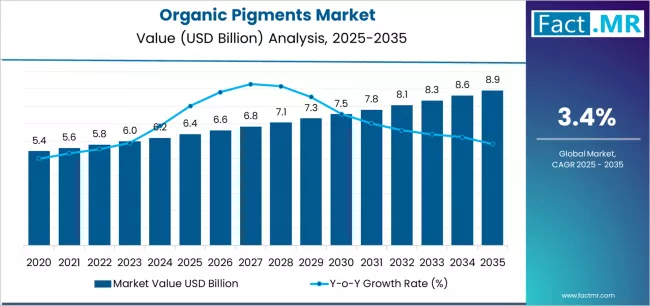
The first half of the decade (2025-2030) will witness the market climbing from USD 6.4 billion to approximately USD 7.4 billion, adding USD 1.0 billion in value, which constitutes 40% of the total forecast growth period. This phase will be characterized by the rapid adoption of azo pigment systems, driven by increasing industrial coating volumes and the growing need for advanced color fastness solutions worldwide. Enhanced lightfastness capabilities and environmental compliance systems will become standard expectations rather than premium options.
The latter half (2030-2035) will witness continued growth from USD 7.4 billion to USD 8.9 billion, representing an addition of USD 1.5 billion or 60% of the decade's expansion. This period will be defined by mass market penetration of advanced organic pigment technologies, integration with comprehensive coating platforms, and seamless compatibility with existing manufacturing infrastructure. The market trajectory signals fundamental shifts in how manufacturers approach color consistency and environmental compliance, with participants positioned to benefit from growing demand across multiple chemistry types and application segments.
The growth of the organic pigments market is further driven by increasing global emphasis on sustainable and eco-friendly manufacturing processes. Regulatory pressures limiting the use of heavy metals and hazardous chemicals in coatings, plastics, and inks are encouraging the adoption of organic alternatives that offer lower environmental impact while maintaining high performance. Manufacturers are investing in research and development to produce pigments with superior heat stability, dispersibility, and opacity, meeting the rising demand for high-quality colorants in automotive coatings, decorative paints, and high-end printing applications.
In addition, the expanding plastics and packaging industries are fueling demand for vibrant and durable organic pigments. Consumer preference for aesthetically appealing and visually striking products is prompting brand owners to seek pigments that deliver consistent color across complex substrates and production methods. Advanced pigments with tailored properties, including UV resistance, anti-migration characteristics, and compatibility with multiple resin systems, are increasingly being integrated into mass production pipelines to meet stringent performance requirements.
Emerging applications in inks for digital printing, functional coatings, and specialty textiles are also opening new growth avenues. Innovations such as solvent-free and waterborne pigment dispersions are gaining traction due to their reduced environmental footprint and compliance with evolving global regulations. Geographically, Asia-Pacific is expected to witness the fastest growth, driven by expanding manufacturing capabilities, urbanization, and increasing demand for high-quality consumer goods. North America and Europe continue to focus on product innovation and sustainability, maintaining their strong presence in the market. Overall, the organic pigments market is poised for steady expansion, underpinned by regulatory compliance, technological innovation, and the rising adoption of eco-conscious industrial solutions.
| Period | Primary Revenue Buckets | Share | Notes |
|---|---|---|---|
| Today | Azo pigments | 46% | Volume-driven, coatings applications |
| Phthalocyanine pigments | 36% | Performance focus, industrial use | |
| HPP/others | 18% | High-performance applications, specialty | |
| Future (3-5 yrs) | Advanced azo systems | 44-48% | Technology enhancement, environmental compliance |
| Enhanced phthalocyanine solutions | 34-38% | Performance optimization, durability positioning | |
| Specialty high-performance varieties | 16-20% | Innovation applications, premium positioning |
Organic Pigments Market Key Takeaways
At-a-Glance Metrics
| Metric | Value |
|---|---|
| Market Value (2025) → | USD 6.4 billion |
| Market Forecast (2035) ↑ | USD 8.9 billion |
| Growth Rate ★ | 3.4% CAGR |
| Leading Product → | Azo Pigments |
| Primary Application → | Coatings Segment |
The market demonstrates strong fundamentals with azo pigments capturing a dominant 46.0% share through advanced color capabilities and performance optimization. Coatings applications drive primary demand with 41.0% market share, supported by increasing industrial coating requirements and color consistency programs.
Geographic expansion remains concentrated in developed markets with established manufacturing infrastructure, while emerging economies show accelerating adoption rates driven by industrialization initiatives and rising quality standards.
Imperatives for Stakeholders in Organic Pigments Market
Design for color versatility, not just tinting strength
- Offer complete color packages: organic pigments + formulation support + documentation + color matching + technical guidance.
- Preconfigured manufacturing workflows: dispersion protocols, quality procedures, color records, and digital tracking on production operations.
Technology readiness for sustainable manufacturing
- Real-time color monitoring analytics, predictive stability capabilities, and smart manufacturing integration (process connectivity, quality tracking systems).
Performance-by-design approach
- Automated dispersion systems, real-time consistency mechanisms, statistical quality monitoring integration, and paperless production documentation.
Value-based colorant models
- Clear base pigment price + transparent service tiers (formulation support, technical availability, performance guarantees); subscriptions for digital services and analytics.
Segmental Analysis
The market segments by chemistry type into azo, phthalocyanine, and HPP/other variants, representing the evolution from basic colorants to specialized pigments for comprehensive industrial and manufacturing optimization.
The application segmentation divides the market into coatings (41.0%), plastics (33.0%), and inks (26.0%) sectors, reflecting distinct requirements for color performance, processing standards, and durability capabilities.
The grade segmentation covers high-performance (55.0%) and commodity (45.0%) categories, addressing different quality requirements from premium applications to cost-effective manufacturing.
The segmentation structure reveals technology progression from standard colorants toward specialized pigment systems with enhanced color consistency and manufacturing capabilities, while application diversity spans from industrial coatings to consumer products requiring precise color solutions.
By Chemistry, the Azo Segment Accounts for Dominant Market Share
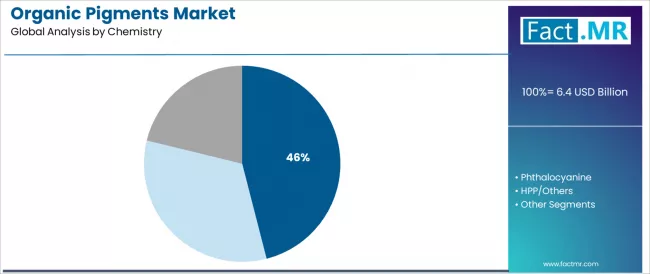
Azo pigments command the leading position in the organic pigments market with 46.0% market share through advanced color characteristics, including superior tinting strength, color brightness, and manufacturing compatibility that enable coating operators to achieve optimal color performance across diverse industrial and decorative applications.
The segment benefits from manufacturer preference for reliable pigment systems that provide consistent color performance, reduced formulation complexity, and manufacturing optimization without requiring significant process modifications. Advanced color features enable automated dispersion systems, quality control, and integration with existing coating equipment, where operational performance and color compliance represent critical manufacturing requirements.
Azo pigment systems differentiate through proven color reliability, consistent performance characteristics, and integration with automated manufacturing systems that enhance production effectiveness while maintaining optimal color standards for diverse coating and industrial applications.
Key market characteristics:
- Advanced pigment designs with optimized color configuration and tinting efficiency capabilities
- Enhanced manufacturing effectiveness, enabling 85-95% color consistency with reliable performance
- Production compatibility, including automated dispersion systems, monitoring integration, and process optimization for pigment performance
Phthalocyanine Systems Show Strong Performance Focus
Phthalocyanine pigments maintain a 36.0% market position in the organic pigments market due to their proven durability and performance characteristics. These systems appeal to manufacturers requiring high-performance coloration with targeted positioning for industrial and automotive applications. Market growth is driven by performance segment expansion, emphasizing reliable durability solutions and color fastness optimization through proven chemistries.
HPP/Other Systems Serve Specialty Applications
HPP/other pigments account for 18.0% market share, serving high-performance applications requiring specialized color performance and advanced characteristics for premium and technical requirements.
By Application, the Coatings Segment Shows Market Leadership
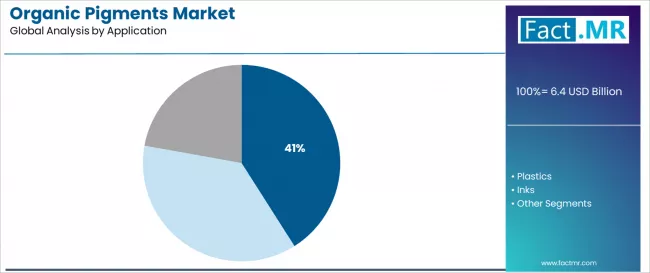
Coatings applications demonstrate market leadership in the organic pigments market with 41.0% share due to widespread adoption of industrial colorant systems and increasing focus on color consistency optimization, durability efficiency, and performance enhancement that maximize coating performance while maintaining quality standards.
Coating manufacturers prioritize pigment consistency, color efficiency, and integration with existing formulation infrastructure that enables coordinated colorant operations across multiple coating systems. The segment benefits from substantial industrial investment and quality programs that emphasize the acquisition of advanced pigment systems for color optimization and performance enhancement applications.
Industrial programs incorporate organic pigments as standard components for coating operations, while performance development growth increases demand for consistent color capabilities that comply with quality standards and minimize formulation costs.
Application dynamics include:
- Strong growth in industrial coatings requiring advanced color capabilities
- Increasing adoption in performance optimization and durability applications for coating manufacturers
- Rising integration with automated manufacturing systems for operational optimization and quality assurance
Plastics Applications Maintain Strong Processing Focus
Plastics applications capture 33.0% market share through comprehensive coloration requirements in polymer operations, plastic manufacturing, and molding projects. These applications demand reliable pigment systems capable of operating in high-temperature conditions while providing effective color integration and processing capabilities.
Inks Applications Show Printing Growth
Inks applications account for 26.0% market share, including printing inks, packaging applications, and specialty requiring efficient pigment solutions for color optimization and print enhancement.
By Grade, the High-Performance Segment Leads Market Share
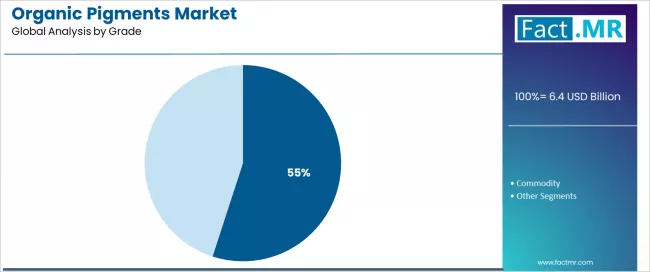
The high-performance segment commands 55.0% market share through widespread adoption in premium applications, quality-focused operations, and specialized projects. These grades provide advanced color solutions for complex performance requirements while maintaining durability flexibility and quality reliability.
Commodity Applications Show Cost-Effective Focus
Commodity grades capture 45.0% market share, serving standard applications, cost-effective operations, and manufacturing requiring enhanced affordability capabilities for market optimization and competitive positioning.
What are the Drivers, Restraints, and Key Trends of the Organic Pigments Market?
| Category | Factor | Impact | Why It Matters |
|---|---|---|---|
| Driver | Industrial growth & coating demand (construction expansion, automotive production) | ★★★★★ | Large-scale industrial expansion requires efficient, high-performance pigment solutions with consistent quality and color integration across coating applications. |
| Driver | Environmental regulations & sustainability focus (VOC reduction, eco-friendly formulations) | ★★★★★ | Drives demand for efficient pigment solutions and environmentally-compliant capabilities; suppliers providing sustainable features gain competitive advantage. |
| Driver | Color innovation & brand differentiation (aesthetic demands, customization trends) | ★★★★☆ | Manufacturers need advanced, distinctive pigment solutions; demand for innovative color features expanding addressable market segments. |
| Restraint | Raw material costs & supply volatility | ★★★★☆ | Small manufacturers face cost pressure; increases price sensitivity and affects adoption in cost-sensitive segments with limited production budgets. |
| Restraint | Regulatory compliance & testing requirements | ★★★☆☆ | Quality-focused operations face challenges with regulatory complexity and specialized testing requirements, limiting adoption in resource-constrained segments. |
| Trend | Smart manufacturing integration & color matching technology | ★★★★★ | Growing demand for intelligent pigment solutions; digital connectivity becomes core value proposition in advanced manufacturing segments. |
| Trend | High-performance applications & specialty coatings | ★★★★☆ | Regional development drives demand for specialty pigment solutions; performance capabilities drive competition toward premiumization. |
Analysis of the Organic Pigments Market by Key Country
The organic pigments market demonstrates varied regional dynamics with growth leaders including USA (3.8% growth rate) and Mexico (3.6% growth rate) driving expansion through industrial manufacturing initiatives and coating development. Strong Performers encompass Germany (3.4% growth rate), France (3.1% growth rate), and UK (2.9% growth rate), benefiting from established chemical industries and advanced pigment adoption. Mature Markets feature South Korea (2.8% growth rate) and Japan (2.7% growth rate), where manufacturing innovation and quality standardization requirements support consistent growth patterns.
Regional synthesis reveals North American markets leading adoption through industrial manufacturing expansion and coating technology development, while European countries maintain steady expansion supported by sustainability advancement and regulatory compliance requirements. Emerging markets show strong growth driven by manufacturing applications and industrial integration trends.
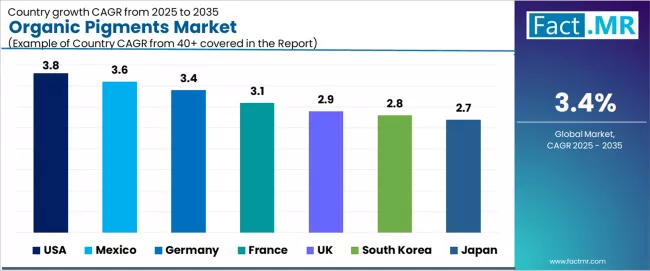
| Region/Country | 2025-2035 Growth | How to win | What to watch out |
|---|---|---|---|
| USA | 3.8% | Focus on industrial manufacturing-focused solutions | Environmental complexity; compliance requirements |
| Mexico | 3.6% | Lead with cost-effective production models | Economic dependencies; supply chain limitations |
| Germany | 3.4% | Value-oriented sustainability models | Over-engineering; regulatory compliance |
| France | 3.1% | Offer premium quality systems | Market maturity; environmental regulations |
| UK | 2.9% | Provide advanced manufacturing integration | Market maturity; production standards |
| South Korea | 2.8% | Push manufacturing innovation applications | Technology costs; domestic competition |
| Japan | 2.7% | Premium quality positioning | Market maturity; precision requirements |
USA Drives Fastest Market Growth
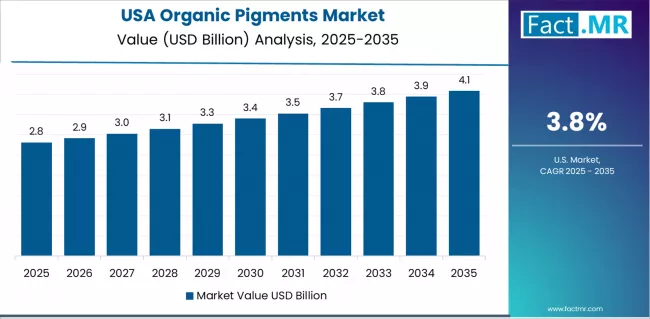
USA establishes fastest market growth through aggressive industrial manufacturing programs and comprehensive coating development, integrating advanced organic pigment systems as standard components in industrial production, automotive coatings, and manufacturing applications. The country's 3.8% growth rate reflects industry initiatives promoting manufacturing efficiency and coating development capabilities that mandate the use of advanced pigment systems in industrial projects. Growth concentrates in major manufacturing centers, including Ohio, Michigan, and Texas, where chemical technology development showcases integrated organic pigment systems that appeal to manufacturers seeking advanced color optimization capabilities and industrial efficiency applications.
American manufacturers are developing industrial manufacturing-focused pigment solutions that combine domestic innovation advantages with advanced color features, including high-performance formulations and enhanced environmental capabilities. Distribution channels through chemical suppliers and coating distributors expand market access, while industry support for manufacturing development supports adoption across diverse industrial segments.
Strategic Market Indicators:
- Industrial manufacturing facilities leading adoption with 92% deployment rate in coating production and chemical sectors
- Manufacturing modernization programs providing substantial demand for domestic chemical technology development
- Local pigment manufacturers capturing 68% market share through competitive pricing and localized technical support
- Export market development for industrial-focused organic pigment solutions targeting emerging manufacturing markets
Mexico Emerges as High-Growth Market
Mexico's market expansion benefits from diverse manufacturing development demand, including industrial production growth in Nuevo León and Jalisco, automotive coating upgrades, and manufacturing programs that increasingly incorporate organic pigment systems for quality optimization applications. The country maintains a 3.6% growth rate, driven by rising industrial activity and increasing recognition of advanced pigment benefits, including enhanced color performance and improved manufacturing functionality.
Market dynamics focus on cost-effective organic pigment solutions that balance advanced color performance with affordability considerations important to Mexican manufacturing operators. Growing industrial development creates continued demand for pigment systems in manufacturing infrastructure and quality enhancement projects.
Strategic Market Indicators:
- Manufacturing facilities leading adoption with 85% deployment rate in industrial and automotive coating sectors
- Government manufacturing initiatives providing substantial support for domestic chemical technology development
- Regional manufacturers capturing 52% market share through competitive pricing and localized support
- Growing export opportunities for cost-effective organic pigment solutions targeting Latin American manufacturing markets
Germany Shows Technology Leadership
Germany's advanced chemical technology market demonstrates sophisticated organic pigment system deployment with documented operational effectiveness in industrial coating applications and specialty manufacturing projects through integration with existing production systems and chemical infrastructure. The country leverages engineering expertise in pigment technology and chemical systems integration to maintain a 3.4% growth rate. Manufacturing centers, including North Rhine-Westphalia, Bavaria, and Baden-Württemberg, showcase premium installations where organic pigment systems integrate with comprehensive chemical platforms and quality management systems to optimize manufacturing operations and color effectiveness.
German manufacturers prioritize system precision and EU compliance in pigment development, creating demand for premium systems with advanced features, including environmental monitoring integration and automated production systems. The market benefits from established chemical technology infrastructure and willingness to invest in advanced pigment technologies that provide long-term performance benefits and compliance with international environmental standards.
Strategic Market Indicators:
- Premium chemical facilities leading adoption with 88% deployment rate in specialty coating and industrial sectors
- EU environmental compliance programs driving substantial investment in advanced pigment technology development
- Local technology manufacturers capturing 58% market share through engineering excellence and regulatory expertise
- Export leadership in high-quality organic pigment solutions targeting developed European chemical markets
France Shows Advanced Chemical Integration
France establishes advanced chemical integration through comprehensive manufacturing industry modernization and technology development, integrating organic pigment systems across production facilities and specialty operations. The country's 3.1% growth rate reflects mature chemical industry relationships and established quality adoption that supports widespread use of pigment systems in commercial and specialty facilities. Growth concentrates in major chemical centers, including Auvergne-Rhône-Alpes, Île-de-France, and Grand Est, where chemical technology showcases mature organic pigment deployment that appeals to operators seeking proven performance capabilities and manufacturing efficiency applications.
French manufacturers leverage established distribution networks and comprehensive chemical processing capabilities, including system integration programs and technical support that create customer relationships and operational advantages. The market benefits from mature chemical standards and quality requirements that mandate pigment system use while supporting technology advancement and manufacturing optimization.
Strategic Market Indicators:
- Specialty chemical facilities leading adoption with 85% deployment rate in premium and industrial manufacturing sectors
- National chemical innovation programs providing substantial funding for pigment technology development
- Domestic manufacturers capturing 55% market share through chemical expertise and quality positioning
- Strong export presence in premium organic pigment solutions targeting global chemical markets
United Kingdom Shows Manufacturing Development
United Kingdom establishes manufacturing development through comprehensive chemical modernization and efficiency integration, integrating organic pigment systems across production operations and specialty applications. The country's 2.9% growth rate reflects growing efficiency investment and increasing adoption of pigment technology that supports expanding use of quality systems in British chemical facilities. Growth concentrates in major regions, including North West, Yorkshire, and West Midlands, where chemical technology development showcases integrated organic pigment systems that appeal to British operators seeking advanced efficiency solutions with performance compatibility.
British manufacturers focus on maintaining quality standards while adopting manufacturing efficiency, creating demand for systems that balance color performance with operational advantages. The market benefits from strong chemical infrastructure and growing efficiency consciousness that support pigment technology adoption while maintaining quality standards important to British chemical applications.
Strategic Market Indicators:
- Efficiency-focused chemical facilities leading adoption with 78% deployment rate in manufacturing and specialty sectors
- Government manufacturing initiatives providing substantial support for chemical innovation and pigment development
- Local manufacturers capturing 48% market share through efficiency-focused positioning and quality standards
- Growing export opportunities in organic pigment solutions targeting Commonwealth and European markets
South Korea Shows Manufacturing Innovation Development

South Korea establishes manufacturing innovation development through comprehensive chemical modernization and technology integration, integrating organic pigment systems across production and electronics applications. The country's 2.8% growth rate reflects growing innovation investment and increasing adoption of pigment technology that supports expanding use of advanced systems in Korean chemical facilities. Growth concentrates in major industrial areas, including Gyeonggi, Ulsan, and Busan, where chemical technology development showcases integrated organic pigment systems that appeal to Korean operators seeking advanced technology solutions with innovation compatibility.
Korean manufacturers focus on maintaining quality standards while adopting chemical innovation, creating demand for systems that balance performance with technological advantages. The market benefits from strong chemical infrastructure and growing export opportunities that support pigment technology adoption while maintaining quality standards important to Korean chemical applications.
Strategic Market Indicators:
- Technology-advanced chemical facilities leading adoption with 75% deployment rate in innovation and electronics sectors
- Government innovation programs providing substantial investment in chemical-focused technology development
- Local manufacturers capturing 45% market share through technological advancement and export excellence
- Strong export growth in premium organic pigment solutions targeting Asian and global chemical markets
Japan Demonstrates Premium Chemical Focus
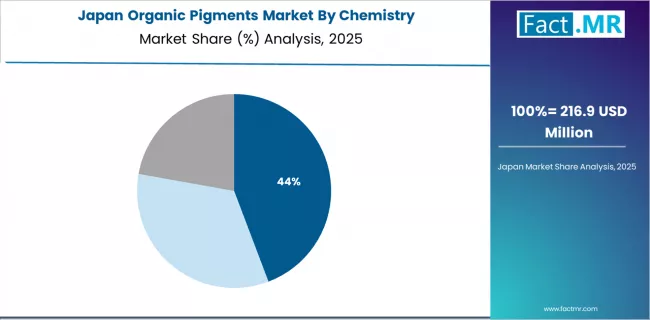
Japan's advanced chemical technology market demonstrates sophisticated organic pigment system deployment with documented operational effectiveness in premium manufacturing applications and specialty chemical projects through integration with existing quality systems and production infrastructure. The country maintains a 2.7% growth rate, leveraging traditional quality expertise and precision systems integration in pigment technology. Chemical centers, including Kanto, Kansai, and Chubu, showcase premium installations where organic pigment systems integrate with traditional quality platforms and modern manufacturing systems to optimize chemical operations and maintain product quality profiles.
Japanese manufacturers prioritize chemical precision and quality consistency in pigment development, creating demand for premium systems with advanced features, including quality monitoring and automated chemical systems. The market benefits from established quality infrastructure and commitment to chemical standards that provide long-term operational benefits and compliance with traditional quality manufacturing methods.
Strategic Market Indicators:
- Premium quality chemical facilities leading adoption with 72% deployment rate in high-end manufacturing and traditional sectors
- Traditional quality programs combined with modern innovation driving substantial investment in precision pigment technology
- Domestic manufacturers capturing 42% market share through quality excellence and precision manufacturing
- Export leadership in ultra-premium organic pigment solutions targeting global premium and luxury chemical markets
Europe Market Split by Country
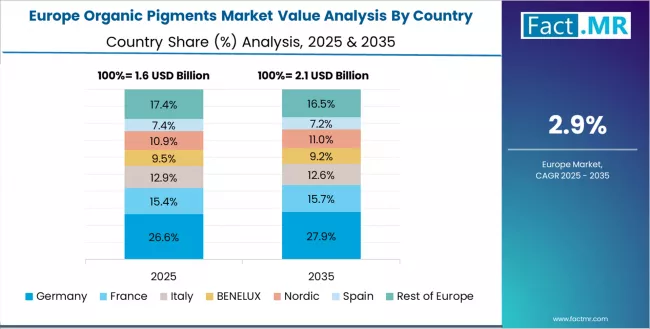
The organic pigments market in Europe is projected to grow from USD 1.9 billion in 2025 to USD 2.5 billion by 2035, registering a CAGR of 2.8% over the forecast period. Germany is expected to maintain its leadership position with a 35.8% market share in 2025, growing to 36.5% by 2035, supported by its advanced chemical infrastructure and major manufacturing centers including North Rhine-Westphalia and Bavaria.
France follows with a 22.1% share in 2025, projected to reach 22.6% by 2035, driven by comprehensive specialty chemical programs and pigment innovation development. The United Kingdom holds a 16.8% share in 2025, expected to maintain 16.3% by 2035 despite market adjustments. Italy commands a 14.7% share, while Spain accounts for 10.6% in 2025.
The Rest of Europe region is anticipated to gain momentum, maintaining its collective share at approximately 10.0% by 2035, attributed to increasing organic pigment adoption in Nordic countries and emerging chemical facilities implementing quality-focused programs.
Competitive Landscape of the Organic Pigments Market
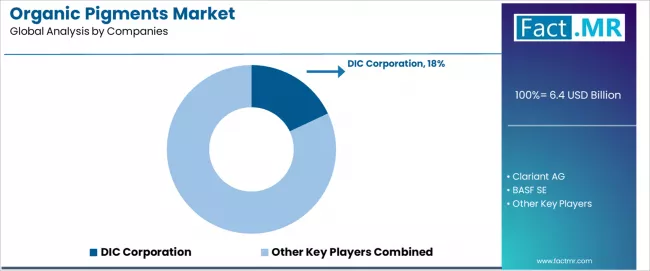
- Structure: ~18-22 credible players; top 5 hold ~52-57% by revenue.
- Leadership is maintained through: chemistry expertise, color innovation, and performance reliability (color consistency + lightfastness + manufacturing integration).
- What's commoditizing: standard azo pigments and basic phthalocyanine configurations.
- Margin Opportunities: specialized high-performance solutions, custom color development, and comprehensive formulation packages (color services, technical support, performance monitoring).
| Stakeholder | What they actually control | Typical strengths | Typical blind spots |
|---|---|---|---|
| Global platforms | Pigment reach, deep chemistry catalogs, production facilities | Broad availability, proven reliability, multi-region projects | Technology refresh cycles; application dependency management |
| Technology innovators | R&D capabilities; advanced pigment systems; color interfaces | Latest technology first; attractive ROI on large projects | Service density outside core regions; customization complexity |
| Regional specialists | Local sourcing, fast delivery, nearby production support | "Close to site" support; pragmatic pricing; local chemical codes | Technology gaps; talent retention in chemical engineering |
| Quality-focused ecosystems | Production consistency, technical support, raw material sourcing | Lowest performance variation; comprehensive support | Production costs if overpromised; technology obsolescence |
| Application specialists | Specialized configurations, custom solutions, chemical development | Win specialized projects; flexible engineering | Scalability limitations; narrow market focus |
Key Players in the Organic Pigments Market
- DIC Corporation
- Clariant AG
- BASF SE
- Heubach GmbH
- Sun Chemical Corporation
- Sudarshan Chemical Industries Ltd.
- Cabot Corporation
- Ferro Corporation
- Toyo Ink SC Holdings Co., Ltd.
- Ishihara Sangyo Kaisha, Ltd.
Scope of the Report
| Items | Values |
|---|---|
| Quantitative Units (2025) | USD 6.4 billion |
| Chemistry | Azo, Phthalocyanine, HPP/Others |
| Application | Coatings, Plastics, Inks |
| Grade | High-Performance, Commodity |
| Regions Covered | North America, Europe, Asia Pacific, South America, Middle East & Africa |
| Countries Covered | USA, Germany, France, United Kingdom, Japan, South Korea, Mexico, and 25+ additional countries |
| Key Companies Profiled | DIC Corporation, Clariant, BASF, Heubach, Sun Chemical, Sudarshan Chemical, Cabot, Ferro |
| Additional Attributes | Dollar sales by chemistry and application categories, regional adoption trends across North America, Europe, and Asia Pacific, competitive landscape with pigment manufacturers and chemical suppliers, manufacturer preferences for pigment consistency and color reliability, integration with manufacturing platforms and quality management systems, innovations in organic pigment technology and color enhancement, and development of advanced pigment solutions with enhanced performance and manufacturing optimization capabilities. |
Organic Pigments Market by Segments
-
Chemistry :
- Azo
- Phthalocyanine
- HPP/Others
-
Application :
- Coatings
- Plastics
- Inks
-
Grade :
- High-Performance
- Commodity
-
Region :
- North America
- USA
- Canada
- Mexico
- Europe
- Germany
- France
- United Kingdom
- Italy
- Spain
- Rest of Europe
- Asia Pacific
- China
- Japan
- South Korea
- India
- ASEAN
- Australia & New Zealand
- Rest of Asia Pacific
- South America
- Brazil
- Rest of South America
- Middle East & Africa
- GCC Countries
- South Africa
- Rest of Middle East & Africa
- North America
Table of Content
- Executive Summary
- Global Market Outlook
- Demand to side Trends
- Supply to side Trends
- Technology Roadmap Analysis
- Analysis and Recommendations
- Market Overview
- Market Coverage / Taxonomy
- Market Definition / Scope / Limitations
- Market Background
- Market Dynamics
- Drivers
- Restraints
- Opportunity
- Trends
- Scenario Forecast
- Demand in Optimistic Scenario
- Demand in Likely Scenario
- Demand in Conservative Scenario
- Opportunity Map Analysis
- Product Life Cycle Analysis
- Supply Chain Analysis
- Investment Feasibility Matrix
- Value Chain Analysis
- PESTLE and Porter’s Analysis
- Regulatory Landscape
- Regional Parent Market Outlook
- Production and Consumption Statistics
- Import and Export Statistics
- Market Dynamics
- Global Market Analysis 2020 to 2024 and Forecast, 2025 to 2035
- Historical Market Size Value (USD Million) Analysis, 2020 to 2024
- Current and Future Market Size Value (USD Million) Projections, 2025 to 2035
- Y to o to Y Growth Trend Analysis
- Absolute $ Opportunity Analysis
- Global Market Pricing Analysis 2020 to 2024 and Forecast 2025 to 2035
- Global Market Analysis 2020 to 2024 and Forecast 2025 to 2035, By Chemistry
- Introduction / Key Findings
- Historical Market Size Value (USD Million) Analysis By Chemistry , 2020 to 2024
- Current and Future Market Size Value (USD Million) Analysis and Forecast By Chemistry , 2025 to 2035
- Azo
- Phthalocyanine
- HPP/Others
- Y to o to Y Growth Trend Analysis By Chemistry , 2020 to 2024
- Absolute $ Opportunity Analysis By Chemistry , 2025 to 2035
- Global Market Analysis 2020 to 2024 and Forecast 2025 to 2035, By Application
- Introduction / Key Findings
- Historical Market Size Value (USD Million) Analysis By Application, 2020 to 2024
- Current and Future Market Size Value (USD Million) Analysis and Forecast By Application, 2025 to 2035
- Coatings
- Plastics
- Inks
- Y to o to Y Growth Trend Analysis By Application, 2020 to 2024
- Absolute $ Opportunity Analysis By Application, 2025 to 2035
- Global Market Analysis 2020 to 2024 and Forecast 2025 to 2035, By Grade
- Introduction / Key Findings
- Historical Market Size Value (USD Million) Analysis By Grade, 2020 to 2024
- Current and Future Market Size Value (USD Million) Analysis and Forecast By Grade, 2025 to 2035
- High-Performance
- Commodity
- Y to o to Y Growth Trend Analysis By Grade, 2020 to 2024
- Absolute $ Opportunity Analysis By Grade, 2025 to 2035
- Global Market Analysis 2020 to 2024 and Forecast 2025 to 2035, By Region
- Introduction
- Historical Market Size Value (USD Million) Analysis By Region, 2020 to 2024
- Current Market Size Value (USD Million) Analysis and Forecast By Region, 2025 to 2035
- North America
- Latin America
- Western Europe
- Eastern Europe
- East Asia
- South Asia and Pacific
- Middle East & Africa
- Market Attractiveness Analysis By Region
- North America Market Analysis 2020 to 2024 and Forecast 2025 to 2035, By Country
- Historical Market Size Value (USD Million) Trend Analysis By Market Taxonomy, 2020 to 2024
- Market Size Value (USD Million) Forecast By Market Taxonomy, 2025 to 2035
- By Country
- USA
- Canada
- Mexico
- By Chemistry
- By Application
- By Grade
- By Country
- Market Attractiveness Analysis
- By Country
- By Chemistry
- By Application
- By Grade
- Key Takeaways
- Latin America Market Analysis 2020 to 2024 and Forecast 2025 to 2035, By Country
- Historical Market Size Value (USD Million) Trend Analysis By Market Taxonomy, 2020 to 2024
- Market Size Value (USD Million) Forecast By Market Taxonomy, 2025 to 2035
- By Country
- Brazil
- Chile
- Rest of Latin America
- By Chemistry
- By Application
- By Grade
- By Country
- Market Attractiveness Analysis
- By Country
- By Chemistry
- By Application
- By Grade
- Key Takeaways
- Western Europe Market Analysis 2020 to 2024 and Forecast 2025 to 2035, By Country
- Historical Market Size Value (USD Million) Trend Analysis By Market Taxonomy, 2020 to 2024
- Market Size Value (USD Million) Forecast By Market Taxonomy, 2025 to 2035
- By Country
- Germany
- UK
- Italy
- Spain
- France
- Nordic
- BENELUX
- Rest of Western Europe
- By Chemistry
- By Application
- By Grade
- By Country
- Market Attractiveness Analysis
- By Country
- By Chemistry
- By Application
- By Grade
- Key Takeaways
- Eastern Europe Market Analysis 2020 to 2024 and Forecast 2025 to 2035, By Country
- Historical Market Size Value (USD Million) Trend Analysis By Market Taxonomy, 2020 to 2024
- Market Size Value (USD Million) Forecast By Market Taxonomy, 2025 to 2035
- By Country
- Russia
- Poland
- Hungary
- Balkan & Baltic
- Rest of Eastern Europe
- By Chemistry
- By Application
- By Grade
- By Country
- Market Attractiveness Analysis
- By Country
- By Chemistry
- By Application
- By Grade
- Key Takeaways
- East Asia Market Analysis 2020 to 2024 and Forecast 2025 to 2035, By Country
- Historical Market Size Value (USD Million) Trend Analysis By Market Taxonomy, 2020 to 2024
- Market Size Value (USD Million) Forecast By Market Taxonomy, 2025 to 2035
- By Country
- China
- Japan
- South Korea
- By Chemistry
- By Application
- By Grade
- By Country
- Market Attractiveness Analysis
- By Country
- By Chemistry
- By Application
- By Grade
- Key Takeaways
- South Asia and Pacific Market Analysis 2020 to 2024 and Forecast 2025 to 2035, By Country
- Historical Market Size Value (USD Million) Trend Analysis By Market Taxonomy, 2020 to 2024
- Market Size Value (USD Million) Forecast By Market Taxonomy, 2025 to 2035
- By Country
- India
- ASEAN
- Australia & New Zealand
- Rest of South Asia and Pacific
- By Chemistry
- By Application
- By Grade
- By Country
- Market Attractiveness Analysis
- By Country
- By Chemistry
- By Application
- By Grade
- Key Takeaways
- Middle East & Africa Market Analysis 2020 to 2024 and Forecast 2025 to 2035, By Country
- Historical Market Size Value (USD Million) Trend Analysis By Market Taxonomy, 2020 to 2024
- Market Size Value (USD Million) Forecast By Market Taxonomy, 2025 to 2035
- By Country
- Kingdom of Saudi Arabia
- Other GCC Countries
- Turkiye
- South Africa
- Other African Union
- Rest of Middle East & Africa
- By Chemistry
- By Application
- By Grade
- By Country
- Market Attractiveness Analysis
- By Country
- By Chemistry
- By Application
- By Grade
- Key Takeaways
- Key Countries Market Analysis
- USA
- Pricing Analysis
- Market Share Analysis, 2024
- By Chemistry
- By Application
- By Grade
- Canada
- Pricing Analysis
- Market Share Analysis, 2024
- By Chemistry
- By Application
- By Grade
- Mexico
- Pricing Analysis
- Market Share Analysis, 2024
- By Chemistry
- By Application
- By Grade
- Brazil
- Pricing Analysis
- Market Share Analysis, 2024
- By Chemistry
- By Application
- By Grade
- Chile
- Pricing Analysis
- Market Share Analysis, 2024
- By Chemistry
- By Application
- By Grade
- Germany
- Pricing Analysis
- Market Share Analysis, 2024
- By Chemistry
- By Application
- By Grade
- UK
- Pricing Analysis
- Market Share Analysis, 2024
- By Chemistry
- By Application
- By Grade
- Italy
- Pricing Analysis
- Market Share Analysis, 2024
- By Chemistry
- By Application
- By Grade
- Spain
- Pricing Analysis
- Market Share Analysis, 2024
- By Chemistry
- By Application
- By Grade
- France
- Pricing Analysis
- Market Share Analysis, 2024
- By Chemistry
- By Application
- By Grade
- India
- Pricing Analysis
- Market Share Analysis, 2024
- By Chemistry
- By Application
- By Grade
- ASEAN
- Pricing Analysis
- Market Share Analysis, 2024
- By Chemistry
- By Application
- By Grade
- Australia & New Zealand
- Pricing Analysis
- Market Share Analysis, 2024
- By Chemistry
- By Application
- By Grade
- China
- Pricing Analysis
- Market Share Analysis, 2024
- By Chemistry
- By Application
- By Grade
- Japan
- Pricing Analysis
- Market Share Analysis, 2024
- By Chemistry
- By Application
- By Grade
- South Korea
- Pricing Analysis
- Market Share Analysis, 2024
- By Chemistry
- By Application
- By Grade
- Russia
- Pricing Analysis
- Market Share Analysis, 2024
- By Chemistry
- By Application
- By Grade
- Poland
- Pricing Analysis
- Market Share Analysis, 2024
- By Chemistry
- By Application
- By Grade
- Hungary
- Pricing Analysis
- Market Share Analysis, 2024
- By Chemistry
- By Application
- By Grade
- Kingdom of Saudi Arabia
- Pricing Analysis
- Market Share Analysis, 2024
- By Chemistry
- By Application
- By Grade
- Turkiye
- Pricing Analysis
- Market Share Analysis, 2024
- By Chemistry
- By Application
- By Grade
- South Africa
- Pricing Analysis
- Market Share Analysis, 2024
- By Chemistry
- By Application
- By Grade
- USA
- Market Structure Analysis
- Competition Dashboard
- Competition Benchmarking
- Market Share Analysis of Top Players
- By Regional
- By Chemistry
- By Application
- By Grade
- Competition Analysis
- Competition Deep Dive
- DIC Corporation
- Overview
- Product Portfolio
- Profitability by Market Segments (Product/Age /Sales Channel/Region)
- Sales Footprint
- Strategy Overview
- Marketing Strategy
- Product Strategy
- Channel Strategy
- Clariant AG
- BASF SE
- Heubach GmbH
- Sun Chemical Corporation
- Sudarshan Chemical Industries Ltd.
- Cabot Corporation
- Ferro Corporation
- Toyo Ink SC Holdings Co., Ltd.
- Ishihara Sangyo Kaisha, Ltd.
- DIC Corporation
- Competition Deep Dive
- Assumptions & Acronyms Used
- Research Methodology
List Of Table
- Table 1: Global Market Value (USD Million) Forecast by Region, 2020 to 2035
- Table 2: Global Market Value (USD Million) Forecast by Chemistry , 2020 to 2035
- Table 3: Global Market Value (USD Million) Forecast by Application, 2020 to 2035
- Table 4: Global Market Value (USD Million) Forecast by Grade, 2020 to 2035
- Table 5: North America Market Value (USD Million) Forecast by Country, 2020 to 2035
- Table 6: North America Market Value (USD Million) Forecast by Chemistry , 2020 to 2035
- Table 7: North America Market Value (USD Million) Forecast by Application, 2020 to 2035
- Table 8: North America Market Value (USD Million) Forecast by Grade, 2020 to 2035
- Table 9: Latin America Market Value (USD Million) Forecast by Country, 2020 to 2035
- Table 10: Latin America Market Value (USD Million) Forecast by Chemistry , 2020 to 2035
- Table 11: Latin America Market Value (USD Million) Forecast by Application, 2020 to 2035
- Table 12: Latin America Market Value (USD Million) Forecast by Grade, 2020 to 2035
- Table 13: Western Europe Market Value (USD Million) Forecast by Country, 2020 to 2035
- Table 14: Western Europe Market Value (USD Million) Forecast by Chemistry , 2020 to 2035
- Table 15: Western Europe Market Value (USD Million) Forecast by Application, 2020 to 2035
- Table 16: Western Europe Market Value (USD Million) Forecast by Grade, 2020 to 2035
- Table 17: Eastern Europe Market Value (USD Million) Forecast by Country, 2020 to 2035
- Table 18: Eastern Europe Market Value (USD Million) Forecast by Chemistry , 2020 to 2035
- Table 19: Eastern Europe Market Value (USD Million) Forecast by Application, 2020 to 2035
- Table 20: Eastern Europe Market Value (USD Million) Forecast by Grade, 2020 to 2035
- Table 21: East Asia Market Value (USD Million) Forecast by Country, 2020 to 2035
- Table 22: East Asia Market Value (USD Million) Forecast by Chemistry , 2020 to 2035
- Table 23: East Asia Market Value (USD Million) Forecast by Application, 2020 to 2035
- Table 24: East Asia Market Value (USD Million) Forecast by Grade, 2020 to 2035
- Table 25: South Asia and Pacific Market Value (USD Million) Forecast by Country, 2020 to 2035
- Table 26: South Asia and Pacific Market Value (USD Million) Forecast by Chemistry , 2020 to 2035
- Table 27: South Asia and Pacific Market Value (USD Million) Forecast by Application, 2020 to 2035
- Table 28: South Asia and Pacific Market Value (USD Million) Forecast by Grade, 2020 to 2035
- Table 29: Middle East & Africa Market Value (USD Million) Forecast by Country, 2020 to 2035
- Table 30: Middle East & Africa Market Value (USD Million) Forecast by Chemistry , 2020 to 2035
- Table 31: Middle East & Africa Market Value (USD Million) Forecast by Application, 2020 to 2035
- Table 32: Middle East & Africa Market Value (USD Million) Forecast by Grade, 2020 to 2035
List Of Figures
- Figure 1: Global Market Pricing Analysis
- Figure 2: Global Market Value (USD Million) Forecast 2020-2035
- Figure 3: Global Market Value Share and BPS Analysis by Chemistry , 2025 and 2035
- Figure 4: Global Market Y to o to Y Growth Comparison by Chemistry , 2025-2035
- Figure 5: Global Market Attractiveness Analysis by Chemistry
- Figure 6: Global Market Value Share and BPS Analysis by Application, 2025 and 2035
- Figure 7: Global Market Y to o to Y Growth Comparison by Application, 2025-2035
- Figure 8: Global Market Attractiveness Analysis by Application
- Figure 9: Global Market Value Share and BPS Analysis by Grade, 2025 and 2035
- Figure 10: Global Market Y to o to Y Growth Comparison by Grade, 2025-2035
- Figure 11: Global Market Attractiveness Analysis by Grade
- Figure 12: Global Market Value (USD Million) Share and BPS Analysis by Region, 2025 and 2035
- Figure 13: Global Market Y to o to Y Growth Comparison by Region, 2025-2035
- Figure 14: Global Market Attractiveness Analysis by Region
- Figure 15: North America Market Incremental Dollar Opportunity, 2025-2035
- Figure 16: Latin America Market Incremental Dollar Opportunity, 2025-2035
- Figure 17: Western Europe Market Incremental Dollar Opportunity, 2025-2035
- Figure 18: Eastern Europe Market Incremental Dollar Opportunity, 2025-2035
- Figure 19: East Asia Market Incremental Dollar Opportunity, 2025-2035
- Figure 20: South Asia and Pacific Market Incremental Dollar Opportunity, 2025-2035
- Figure 21: Middle East & Africa Market Incremental Dollar Opportunity, 2025-2035
- Figure 22: North America Market Value Share and BPS Analysis by Country, 2025 and 2035
- Figure 23: North America Market Value Share and BPS Analysis by Chemistry , 2025 and 2035
- Figure 24: North America Market Y to o to Y Growth Comparison by Chemistry , 2025-2035
- Figure 25: North America Market Attractiveness Analysis by Chemistry
- Figure 26: North America Market Value Share and BPS Analysis by Application, 2025 and 2035
- Figure 27: North America Market Y to o to Y Growth Comparison by Application, 2025-2035
- Figure 28: North America Market Attractiveness Analysis by Application
- Figure 29: North America Market Value Share and BPS Analysis by Grade, 2025 and 2035
- Figure 30: North America Market Y to o to Y Growth Comparison by Grade, 2025-2035
- Figure 31: North America Market Attractiveness Analysis by Grade
- Figure 32: Latin America Market Value Share and BPS Analysis by Country, 2025 and 2035
- Figure 33: Latin America Market Value Share and BPS Analysis by Chemistry , 2025 and 2035
- Figure 34: Latin America Market Y to o to Y Growth Comparison by Chemistry , 2025-2035
- Figure 35: Latin America Market Attractiveness Analysis by Chemistry
- Figure 36: Latin America Market Value Share and BPS Analysis by Application, 2025 and 2035
- Figure 37: Latin America Market Y to o to Y Growth Comparison by Application, 2025-2035
- Figure 38: Latin America Market Attractiveness Analysis by Application
- Figure 39: Latin America Market Value Share and BPS Analysis by Grade, 2025 and 2035
- Figure 40: Latin America Market Y to o to Y Growth Comparison by Grade, 2025-2035
- Figure 41: Latin America Market Attractiveness Analysis by Grade
- Figure 42: Western Europe Market Value Share and BPS Analysis by Country, 2025 and 2035
- Figure 43: Western Europe Market Value Share and BPS Analysis by Chemistry , 2025 and 2035
- Figure 44: Western Europe Market Y to o to Y Growth Comparison by Chemistry , 2025-2035
- Figure 45: Western Europe Market Attractiveness Analysis by Chemistry
- Figure 46: Western Europe Market Value Share and BPS Analysis by Application, 2025 and 2035
- Figure 47: Western Europe Market Y to o to Y Growth Comparison by Application, 2025-2035
- Figure 48: Western Europe Market Attractiveness Analysis by Application
- Figure 49: Western Europe Market Value Share and BPS Analysis by Grade, 2025 and 2035
- Figure 50: Western Europe Market Y to o to Y Growth Comparison by Grade, 2025-2035
- Figure 51: Western Europe Market Attractiveness Analysis by Grade
- Figure 52: Eastern Europe Market Value Share and BPS Analysis by Country, 2025 and 2035
- Figure 53: Eastern Europe Market Value Share and BPS Analysis by Chemistry , 2025 and 2035
- Figure 54: Eastern Europe Market Y to o to Y Growth Comparison by Chemistry , 2025-2035
- Figure 55: Eastern Europe Market Attractiveness Analysis by Chemistry
- Figure 56: Eastern Europe Market Value Share and BPS Analysis by Application, 2025 and 2035
- Figure 57: Eastern Europe Market Y to o to Y Growth Comparison by Application, 2025-2035
- Figure 58: Eastern Europe Market Attractiveness Analysis by Application
- Figure 59: Eastern Europe Market Value Share and BPS Analysis by Grade, 2025 and 2035
- Figure 60: Eastern Europe Market Y to o to Y Growth Comparison by Grade, 2025-2035
- Figure 61: Eastern Europe Market Attractiveness Analysis by Grade
- Figure 62: East Asia Market Value Share and BPS Analysis by Country, 2025 and 2035
- Figure 63: East Asia Market Value Share and BPS Analysis by Chemistry , 2025 and 2035
- Figure 64: East Asia Market Y to o to Y Growth Comparison by Chemistry , 2025-2035
- Figure 65: East Asia Market Attractiveness Analysis by Chemistry
- Figure 66: East Asia Market Value Share and BPS Analysis by Application, 2025 and 2035
- Figure 67: East Asia Market Y to o to Y Growth Comparison by Application, 2025-2035
- Figure 68: East Asia Market Attractiveness Analysis by Application
- Figure 69: East Asia Market Value Share and BPS Analysis by Grade, 2025 and 2035
- Figure 70: East Asia Market Y to o to Y Growth Comparison by Grade, 2025-2035
- Figure 71: East Asia Market Attractiveness Analysis by Grade
- Figure 72: South Asia and Pacific Market Value Share and BPS Analysis by Country, 2025 and 2035
- Figure 73: South Asia and Pacific Market Value Share and BPS Analysis by Chemistry , 2025 and 2035
- Figure 74: South Asia and Pacific Market Y to o to Y Growth Comparison by Chemistry , 2025-2035
- Figure 75: South Asia and Pacific Market Attractiveness Analysis by Chemistry
- Figure 76: South Asia and Pacific Market Value Share and BPS Analysis by Application, 2025 and 2035
- Figure 77: South Asia and Pacific Market Y to o to Y Growth Comparison by Application, 2025-2035
- Figure 78: South Asia and Pacific Market Attractiveness Analysis by Application
- Figure 79: South Asia and Pacific Market Value Share and BPS Analysis by Grade, 2025 and 2035
- Figure 80: South Asia and Pacific Market Y to o to Y Growth Comparison by Grade, 2025-2035
- Figure 81: South Asia and Pacific Market Attractiveness Analysis by Grade
- Figure 82: Middle East & Africa Market Value Share and BPS Analysis by Country, 2025 and 2035
- Figure 83: Middle East & Africa Market Value Share and BPS Analysis by Chemistry , 2025 and 2035
- Figure 84: Middle East & Africa Market Y to o to Y Growth Comparison by Chemistry , 2025-2035
- Figure 85: Middle East & Africa Market Attractiveness Analysis by Chemistry
- Figure 86: Middle East & Africa Market Value Share and BPS Analysis by Application, 2025 and 2035
- Figure 87: Middle East & Africa Market Y to o to Y Growth Comparison by Application, 2025-2035
- Figure 88: Middle East & Africa Market Attractiveness Analysis by Application
- Figure 89: Middle East & Africa Market Value Share and BPS Analysis by Grade, 2025 and 2035
- Figure 90: Middle East & Africa Market Y to o to Y Growth Comparison by Grade, 2025-2035
- Figure 91: Middle East & Africa Market Attractiveness Analysis by Grade
- Figure 92: Global Market - Tier Structure Analysis
- Figure 93: Global Market - Company Share Analysis
- FAQs -
How big is the organic pigments market in 2025?
The global organic pigments market is estimated to be valued at USD 6.4 billion in 2025.
What will be the size of organic pigments market in 2035?
The market size for the organic pigments market is projected to reach USD 8.9 billion by 2035.
How much will be the organic pigments market growth between 2025 and 2035?
The organic pigments market is expected to grow at a 3.4% CAGR between 2025 and 2035.
What are the key product types in the organic pigments market?
The key product types in organic pigments market are azo, phthalocyanine and hpp/others.
Which application segment to contribute significant share in the organic pigments market in 2025?
In terms of application, coatings segment to command 41.0% share in the organic pigments market in 2025.